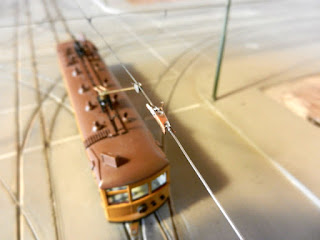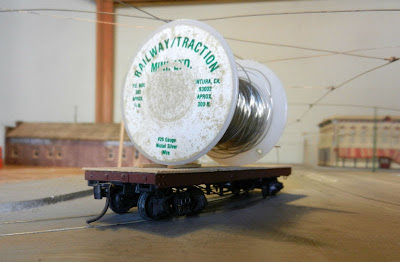7 Years of Bloggety Blah Blab Blog and the Cars are Finally Rolling!
What a difference a year makes. With my job going on hiatus (
and then, unfortunately, cancellation) I was able to turn much of my attention to the layout. And finally, after all these years, the layout has transformed from a plywood monstrosity to a working, running model trolley layout, with
damn fancy trackwork that, lo and behold, actually
works as designed! Its still a plywood monstrosity though. So without any further ado, it that time of year again for:
The Annual State of the Company, Board of Directors Meeting of
The Dan D. Sparks Plywood Development and Transportation Co.
A Figment of the Imagination Corporation (the “Company”)
Held on 22nd September 2013, 8:00 AM Specific Daylight Time
at the offices of the Company, San Dollar, California.
Board Members Present:
President: A placated Dan D. Sparks
Chairman: The very relieved Lettuceleaf M. Malone
Traffic Manager: The hot-headed Robin DeRail
Finance Manager: The always cool Count DeMonet
Director of Development: The fidgety Arnie Clever
General Manager: The lethargic David Lyman
Quorum present? Questionably so.
Others Present:
Technology Genius: Volkmar Meier
Man of Mystery: Fred Gurzeler
Company Orchestra leader: Bill Bolton & Orchestra
Absent: That guy who was tying to tell us something vitally important.
Proceedings:
· Chair, Lettuceleaf M. Malon called the
Meeting to order at 3:03 p.m.
- Secretary Mrs, Roundbottom recorded the minutes.
· Secretary Roundbottom presented to the Board the minutes of the Sept. 2012 meeting of the Board for approval, whereupon
motion duly made, seconded and unanimously refuted as a pack of lies.
 Opening Message from the Chairman:
Opening Message from the Chairman:
In a spectacular turnaround, this blogs "fiscal" year (Sept 2012 to Sept 2013) saw excellent progress on this little railroad of ours. The streetcars (all two of them) are running under power supplied by the overhead (Which fulfills a major requirement of the
2013 New Years Resolution). This Railroad is now a working railroad.
· Traffic Managers Report Provided by Chair, Robin DeRail:

~ Aye! Because of light blog postings last year, the first 5 weeks of this year saw a dismal decline in viewership. But that decline was nixed with a real zinger of a post
Jumping on the 3D Bandwagon! Apparently the folks are real interested with this latest 3D Printing craze and wanted to see what we were up to with our
Switch Tower and whatnot. This blog saw a mighty spike in viewership with a record 283 views in one week with that post! After that, postings have been almost weekly, helping viewership remain stable for most of the year. Once layout construction was well under way, viewership has seen a nice upswing. When videos are posted, traffic really ticks upwards. We need more videos!
Aye! Look! I got a chart!:
Unique weekly blog hits (visitors, not page hits) from 9/21/2012 to 9/21/2013
~ What else... aye yes! This blog hosted 3,355 visitors this last year (Sept. 2012 to Sept. 2013). That's up slightly from 3,064 last year, and 1,939 the year before that. They visited 6,621 times, up from 5,484 times last year and 3,379 times the year before that. That makes for an all time grand total of 23,983 visitors.
~ This blog is now averaging 20 visitors per day, but viewing duration declined slightly to a minute and a half (1:39). That's a 20% gain of visitors from 15 average daily visitors viewing for almost 2 minutes (1:52) last year.
~ The top 3 posts visited this last year were:
1.
Birney #301
· Finance Committee report provided by Chair, Count DeMonet:

~ The Count reported that revenue from ads (the only source of revenue) on this blog earned an average of $0.06 per day, up from $0.04 last year and $0.02 the previous year.
~ DeMonet continued with that the annual earnings for this last fiscal year are estimated at a record $22.78. That's up from $16.07 last year and $7.34 the previous year. This now brings the grand total to $62.26. He reminded us that we won't see a cent of this until the blog earns over $100. Debates raged over how to spend it, though the consensus seems to be to either invest it back into the blog somehow or into the layout itself.
~ The Finance Chair went on to try to persuade the Board that placing a banner ad above or below the blog title, as is typical with almost all websites, would increase revenue appreciatively. As it is now, all ads are "below the fold", and no revenue is gained unless the viewer scrolls down and the ads load. This sparked a raging debate over the artistic integrity of this blog.
· Board Development Committee's report provided by Chair, Arnie Clever:
~ Mr. Clever lamented the fact that with the razor sharp focus on getting the layout running, very little of the companies resources have gone to his planning department.

~ Despite this, "Good 'ol Arnie" continued, much is still needed to be planned. With the layout running now, what comes next? Usually, when the trackwork is complete, the next step is scenicing. And what with this being a city layout, the scenery this case are buildings. But! Arnie pointed out, the poles on
1920's street are temporary and are installed in the building lots next to the sidewalk until the specifics about the permanent poles are determined and the sidewalks drilled for them. So the next logical step is designing and building
these complex poles. Only then can the temporary poles be removed from the lots, freeing up the space for buildings.
~ The Development Chair also revealed new plans for modules to be built for the Southern California Traction Club layout. So as not to interfere with construction of the layout, these modules will built at the clubs regular Sunday meetings.
Mr Sparks closed the meeting with remarks that pretty much boil down to, "well lets wrap this up and go run some trolleys. Yes sir! Lets go run some trolleys!
· Meeting adjourned at 3:05 p.m.
· Minutes submitted by Secretary, Mrs. Roundbottom.
Come back again because the next post will feature a video of the trolleys running. Yes sir! A video of the trolleys running!
Dandy



















































